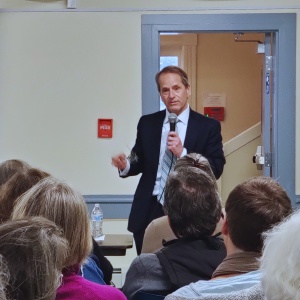Viewpoint: Russell Bastedo – New Hampshire helps create a new party
| Published: 04-04-2023 9:00 AM |
Americans had debated whether to abolish or retain slavery for decads since the Declaration of Independence had been signed in 1776. Most if not all of the men signing the declaration were slave-owners, and slavery in British North America dated back more than 150 years before 1776. The Mother Country demanded ever more “product” from British North America, and British emigratino to the colonies could not satisfy the demand from London.
But forces demanding an end to slavery in British North America were a constant challenge to the colonies’ political power structures. In New Hampshire, a leading advocate for the abolition of slavery was John Parker Hale, whose abolitionist views were so extreme that he was expelled from the state’s Democratic Party in 1845. The Democrats at that time advocated that each state should have the right to decide the slavery question; slavery as a moral and religious issue was best avoided, and the country could not afford the loss of its labor base.
Hale was promptly elected to the U.S. Senate, serving from 1847 to 1852, and in 1852 New Hampshire voters recognized Hale’s creation of a new political party, the Free Soil Party, giving Hale 155,000 votes in the 1852 national election.
Hale used his new national stature to pull together other small groups – the Know-Nothings, the Greenback Party and other like-minded groups – and in 1856, the new Republican Party was on the ballot with a national candidate for the presidency, Gen. John C. Fremont, and a platform calling for the abolition of slavery nationwide.
Fremont gave his name to a New Hampshire town, but was rejected by the nation’s voters in the 1856 national election. In the 1860 presidential election, however, the Republicans carried the day.
Hale’s statue stands upon the New Hampshire State House lawn. In 1890, Hale’s son-in-law, U.S. Sen. William E. Chandler, wrote the New Hampshire governor and council that he wished to commission a statue for the State House lawn. Chandler wrote that the statue wold be cast at the same foundry that had cast the State House statue of Daniel Webster, so that both statues would match each other in finish and in size.
The new statue was dedicated Aug. 3, 1892, a fitting memorial to the New Hampshire founder of the Republican Party.
Russell Bastedo of Dublin is a retired New Hampshire state curator.

 Peterborough voters approve a $11.7 million bond to fund a new Fire and Rescue Station
Peterborough voters approve a $11.7 million bond to fund a new Fire and Rescue Station ConVal’s Kimberly Rizzo Saunders named Superintendent of the Year
ConVal’s Kimberly Rizzo Saunders named Superintendent of the Year Reality Check receives approval to move into Redeeming Grace Church
Reality Check receives approval to move into Redeeming Grace Church Frank Edelblut speaks at Dublin Education Advisory Committee forum
Frank Edelblut speaks at Dublin Education Advisory Committee forum New look at Gregg Lake
New look at Gregg Lake L. Phillips Runyon III – Personal freedom and the common good
L. Phillips Runyon III – Personal freedom and the common good Robert Beck: Disturbing demographic trends
Robert Beck: Disturbing demographic trends
